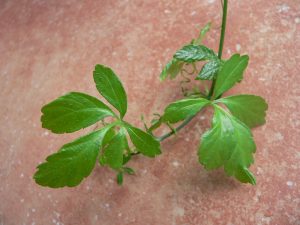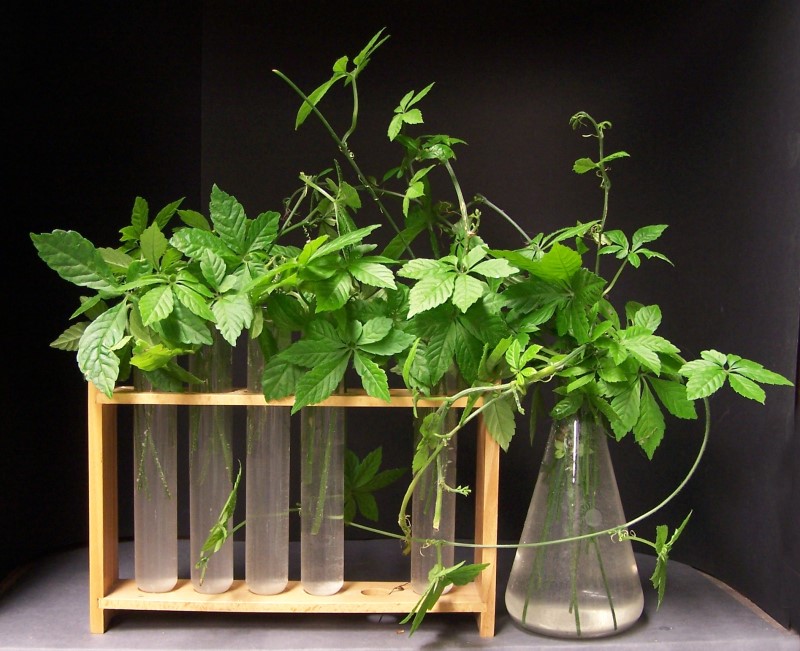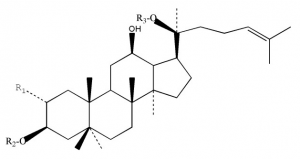Gynostemma pentaphyllum shows early indications of promoting fat loss in obese individuals.

- Activating AMPK. The activation of this enzyme has been associated with fat loss.
Overview
Gynostemma pentaphyllum is a climbing vine native to China, Vietnam, Korea, and Japan. It boasts a rich history as a health-promoting herb in traditional Chinese medicine, where it is known as jiaogulan, or “twisting indigo plant.”
Modern medicine has uncovered a number of health benefits stemming from the leaves of the plant. Its primary bioactive ingredients – ginsenosides, so called for being the active ingredients in Asian ginseng – are known to promote antioxidant1 and adaptogenic effects such as:
- Improving cardiovascular function2
- Diminishing high cholesterol and blood sugar
- Stabilizing blood pressure
Uniquely, Gynostemma is also full of gypenosides, which are substances that have demonstrated anti-diabetic properties, specifically in terms of balancing sugar and cholesterol levels characteristic of type II diabetes. It is these effects that have led to the claims that it can also promote weight loss.

How Gynostemma Pentaphyllum Might Help With Fat Loss

Activating AMPK
5′ adenosine monophosphate-
- Increasing glucose uptake
- Increasing fat metabolism
- Reducing protein production
- Decreasing lipid (fat) synthesis
Gynostemma pentaphyllum was found to lessen obesity by significantly stimulating fat oxidation and glucose uptake through AMPK activation.5 6 Check out our fat burner guide for more details on fat oxidation.
Gynostemma Pentaphyllum Benefits & Uses for Fat Loss
Gynostemma pentaphyllum is popularly used as a weight loss supplement. More than simply a fat burner, it has also demonstrated potential in the treatment of medical conditions associated with excess fat, including:
But while there is plenty of evidence that G. pentaphyllum can help alleviate diabetes, its ability to promote fat loss is based on only a handful of studies. As such, it’s too early to say if it truly works as a weight loss pill.
Research
Animal Research
Animal research indicates that Gynostemma pentaphyllum may be able to:
- Regulate lipid (fat) metabolism and cholesterol levels in rats with hyperlipidemia9 10
- Improve glucose tolerance in rats11 12
Human Research
Early clinical research suggests that Gynostemma pentaphyllum may help fight obesity.
Gynostemma as actiponin™ (450 mg) may promote fat loss in obese adults
In this randomized, double-blind, placebo-controlled investigation, 80 obese Koreans were given either a placebo or Gynostemma pentaphyllum in the form of actiponin™ at 450 mg per day for 12 weeks. Compared to the placebo, actiponin™ supplementation led to significant decreases in weight, BMI, total abdominal fat area, body fat mass, and percent body fat.
- The researchers concluded that “actiponin supplementation may be effective for treating obese individuals.”13
Gynostemma pentaphyllum (80 ml) may reduce BMI in persons with nonalcoholic fatty liver disease
In this randomized, single-blind investigation, 56 people with nonalcoholic fatty liver were given either a placebo a Gynostemma pentaphyllum extract capsule (80 ml) every day for 4 months. At the end of the study, significant reductions in body mass index (BMI) were reported in the Gynostemma pentaphyllum group.
- The researchers concluded that “GP is an effective adjunct treatment to diet therapy for patients with nonalcoholic fatty liver disease.”14
Dosage for Fat Loss
- Successful clinical research studies have use 450 mg of encapsulated Gynostemma pentaphyllum or 6 g of brewed whole leaves.
- Typical Gynostemma pentaphyllum supplements range from 1 – 2 g.
Available Forms
- 20:1 leaf extract in capsules or as a loose powder
- Dried whole leaf as a broth or tea
Supplements in Review Says
- Gynostemma pentaphyllum 450 mg for fat loss.
G. pentaphyllum shows potential for promoting fat loss. Although it’s too early to recommend, early research indicates that Gynostemma pentaphyllum can promote fat loss in obese individuals.
Start with 450 mg doses. We recommend taking 450 mg of Gynostemma powder or capsules, though it can also be taken in the form of leaves (6 g) steeped in hot water for tea.
Leave a Reply